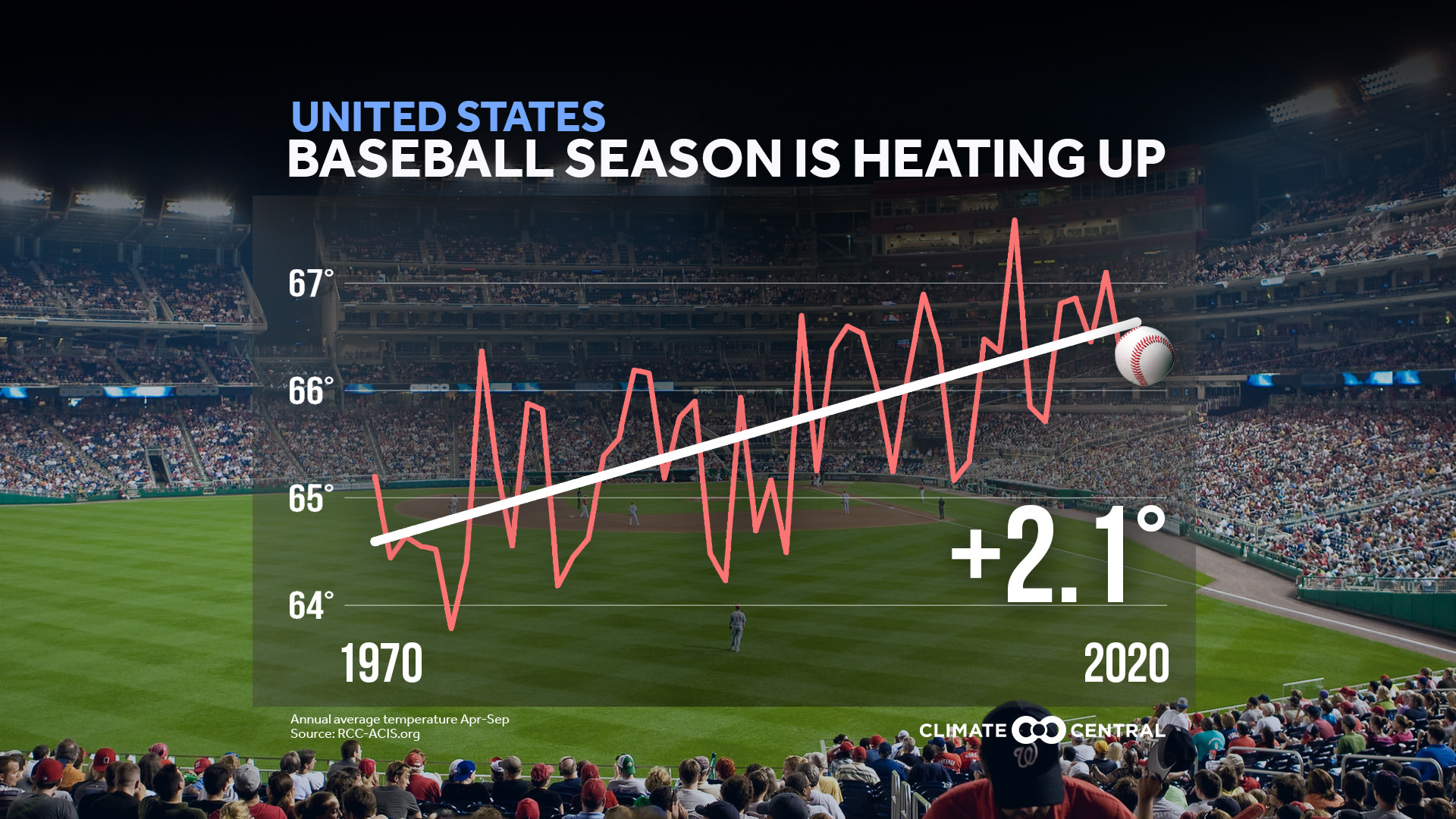KEY CONCEPTS
Opening day is tomorrow, and the baseball season is warming up due to climate change.
Since 1970, Major League Baseball (MLB) cities have warmed an average of 2.1°F during the baseball season. The greatest warming occurred in Toronto for the Blue Jays (warmed by 5.2°F) while the least occurred in Oakland, California for the Athletics (cooled by only 0.1°F).
As temperatures increase, so does the frequency of heavy rain events and bouts of extreme heat—weather conditions which can postpone games and impact the health of players and fans. And for baseball stats enthusiasts, it can also affect the probability of homeruns.
MLB has taken strides to become more green and sustainable in recent years, including LEED (Leadership in Energy and Environmental Design)-certified stadiums, LED field lights, solar energy use, and more.
Opening day is just around the corner, and after a shortened 2020 season, fans are ready to head back to the ballpark. However, similar to spring, summer, fall, and winter, the baseball season overall is warming up—impacting the game, players, and fans.
Climate Central pulled average temperature data for all 27 Major League Baseball (MLB) cities (some teams share a city). Since 1970, MLB cities have warmed an average of 2.1°F. The greatest warming occurred in Toronto for the Blue Jays (warmed by 5.2°F) while the least occurred in Oakland, California for the Athletics (cooled a tad by 0.1°F).
From pre-season to the World Series, the full baseball season spans from late March to early November, ecompassinging a wide range of temperatures (we focused on the regular season for this analysis). However, most of the season occurs during the hottest months of the year when players and fans are at risk of heat-related illnesses. Heat stroke and exhaustion occur when the body overheats and can’t cool down. Symptoms like dizziness, weakness, and cramping take over and can be deadly. As temperatures rise in MLB cities and across the U.S., expect more record-breaking heat and longer heat waves. In addition to extreme heat, heavy rainfall events strengthened by climate change can also disrupt the season. In 2018, 28 games were delayed or canceled due to inclement weather in the first month of the baseball season, the highest number since records began in 1983. Under a warmer climate, some regions will continue to get wetter, particularly in the Northeast and Midwest where 12 out of the 30 MLB teams are based.
But that’s not all. Climate change is throwing another curveball—it can affect the number of home runs. In a warmer and more humid environment (among other factors), baseballs are able to travel farther. The simple breakdown is warmer, humid air is less dense than colder, drier air, so there's less resistance for a flying ball. This is good news for fans of the long ball because rising temperatures in the future could mean more home runs.
MLB has taken strides to become more green and sustainable in recent years. For instance, seven MLB stadiums have LEED (Leadership in Energy and Environmental Design) certification by becoming more energy efficient and cutting down on water consumption. Also, 10 MLB ballparks have implemented solar energy, 19 clubs have installed LED field lights, and as a whole in 2018, their clubs diverted more than 20,000 tons of recyclable or compostable waste from landfills. You can check out more specific sustainability initiatives and green partnerships through 2019 here.
POTENTIAL LOCAL STORY ANGLE
How are sports teams near you reacting to climate change?
Check out the Green Sports Alliance to see if your favorite pro baseball team is among its members. You can also check out your major and/or minor league baseball team’s websites to find their individual green initiatives or sustainability reports. The impacts of climate change, like extreme heat, also apply to other levels of baseball. If your town doesn’t have a pro team, you can contact local Little League softball and baseball teams or other local amateur organized sports leagues to find out what precautions they are taking for athletes and spectators against extreme heat, and if they have any environmental sustainability programs
LOCAL EXPERTS
The SciLine service, 500 Women Scientists or the press offices of local universities may be able to connect you with local scientists who have expertise on climate change in your area.
The American Association of State Climatologists is a professional scientific organization composed of all 50 state climatologists. Find and contact your state climatologist.
You can also check in with your state’s high school sports association to find out what state-level policies are in place to ensure the safety of athletes during extreme heat conditions.
Or contact the Korey Stringer Institute to speak with “ambassadors” from around the country who have personal stories regarding heat exertional illness.
NATIONAL EXPERTS
Dr. Jennifer Vanos, Ph.D.
Assistant Professor, School of Sustainability, Arizona State University
Discussion topics: human biometeorology, extreme heat, climate change, public health
jenni.vanos@asu.eduDr. Brian McCullough, Ph.D.
Associate Professor of Sport Management, Texas A&M University
Discussion topics: sports and climate change/climate action and fan engagement/behavioral change
Contact: brian.mccullough@tamu.edu / 979-458-7825
METHODOLOGY
Temperature trends plot data from the Applied Climate Information System, based on a mathematical linear regression. MLB graphics use the average temperature during baseball season (April - September) in each of the 27 MLB cities (representing 30 teams).
